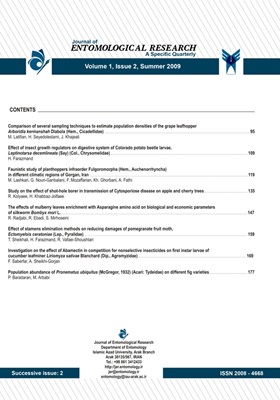Comparison of several sampling techniques to estimate population densities of the grape leafhopper Arboridia kermanshah Dlabola (Hem., Cicadellidae)
Subject Areas : entomology and othea arthropodsM. Latifian 1 , H. Seyedoleslami 2 , J. Khajeali 3
1 - Date Palm and Tropical Fruits Research Institute
2 - Plant Protection Department, Agricultural Faculty, Isfahan University of Technology
3 - Plant Protection Department, Agricultural Faculty, Isfahan University of Technology
Keywords:
Abstract :
Several sampling techniques including sweeping net, D-Vac traps for adults and three different methods of nymph counting (direct count, leaf washing and suction method) were compared in two vineyards in Isfahan, in 1996-1997. Adult grape leafhopper were sampled weekly by sweeping net (10 sample per vineyard) and D-Vac apparatus (10 samples per vineyard each sample unit consisted of 3 minutes suction). Number of nymphs was recorded weekly on leaves. Sample unit was three leaves per tree taken from three strata in the vine canopy of 10 trees. Two parameters including relative variation (RV) and relative net precision (RNP) were used for comparing the sampling methods. Results showed that the best duration time of sampling unit to catch adults was 120-180s by D-Vac. Sweeping net (RV= 18.87 and RNP=2.88) was more suitable than D-Vac in IPM sampling program for the method using D-Vac apparatus. D-Vac was more suitable for studying the adult population fluctuations because of a minimum RV during the season. But its sampling costs was more than other methods. Washing method (RV= 2.9 and RNP= 13.3) was more suitable than direct counting and vacuum in IPM sampling program for nymphs. All three methods were suitable for ecological studies of nymphs but their efficiencies were different for different nymph instars.


